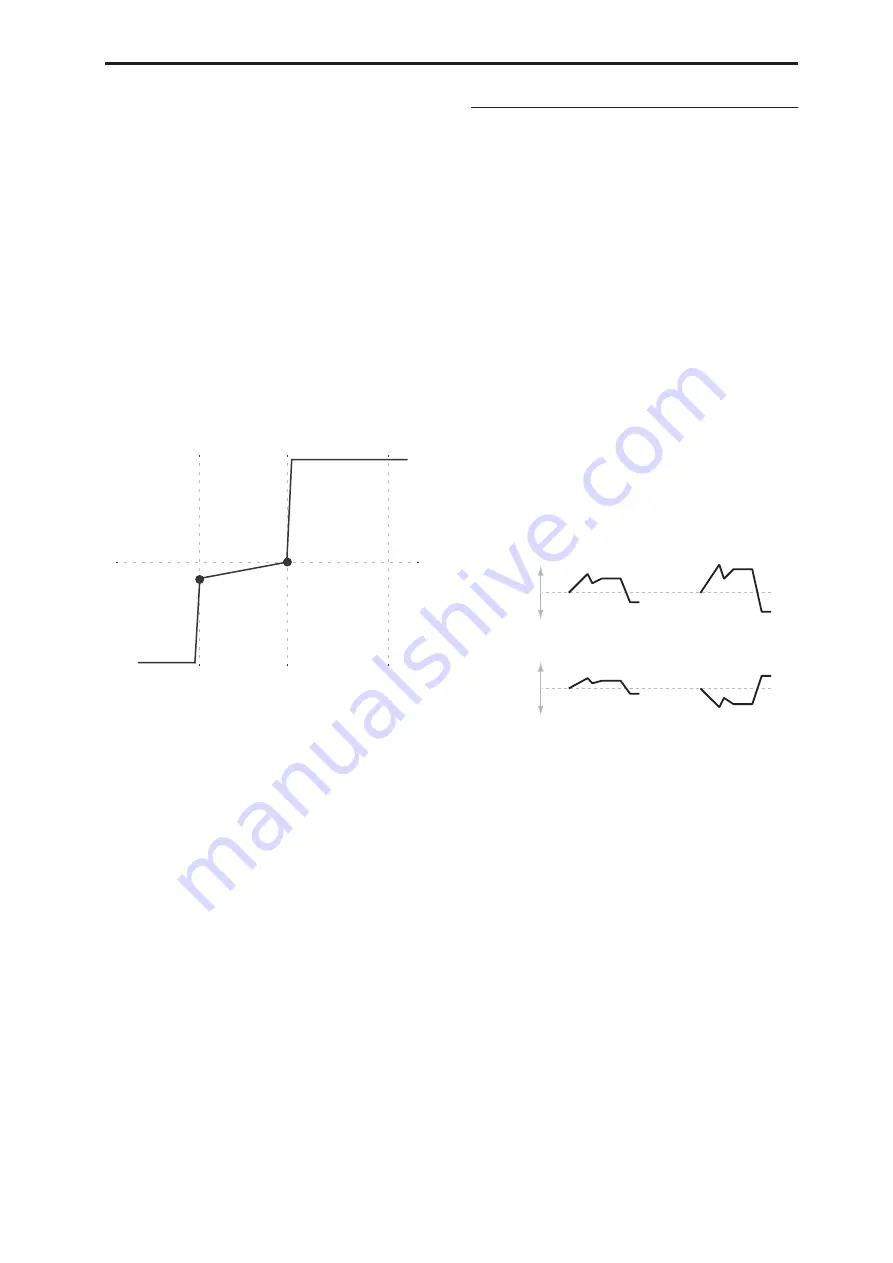
Program P3: Filter 3–2: Filter1 Modulation
65
Low-Center
[–Inf, –99…+99, +Inf]
This sets the slope between the Low Break and Center
keys. For normal key track, use negative values.
Center-High
[–Inf, –99…+99, +Inf]
This sets the slope between the Center and High Break
keys. For normal key track, use positive values.
High-Top
[–Inf, –99…+99, +Inf]
This sets the slope between the High Break key and the
top of the MIDI note range. For normal key track, use
positive values.
+Inf and –Inf ramps
+Inf and –Inf are special settings which create abrupt
changes for split-like effects. When a ramp is set to +Inf
or –Inf, the keyboard tracking will go to its extreme
highest or lowest value over the span of a single key.
+Inf and –Inf Ramps
Note:
if you set the Center-High ramp to +Inf or –Inf,
the High-Top parameter will be grayed out. Similarly,
if you set the Low-Center ramp to +Inf or –Inf, the
Bottom-Low ramp will be grayed out.
Key Follow
To create the classic Key Follow effect, in which the
filter frequency tracks the pitch of the keyboard:
1. Set the Filter Frequency to 30.
2. Set the Keyboard Track Intensity to +99.
3. Set the Bottom-Low and Low-Center ramps to –50.
4. Set the Center-High and High-Top ramps to +50.
5. Set the Center Key to C4.
The settings for the Low Break and High Break keys
don’t matter in this case.
Filter Keyboard Track is also an AMS
source
You can use the keyboard tracking as an AMS source to
modulate other parameters, just like the envelopes and
LFOs. Simply select Filter Keytrack in the AMS list for
the desired parameter.
3–2b: Filter EG
The Filter1 EG modulates the Filter A and B cutoff
frequencies over time. You can control how strongly
the EG will affect the filters in three different ways:
• Set an initial amount of EG modulation, using the
Intensity to A and B parameters.
• Use velocity to scale the amount of the EG applied
to the filter.
• Use any AMS source to scale the amount of the EG
applied to the filter.
You can use all three of these at once, and the results
are added together to produce the total EG effect.
To set up the EG itself, including attack and release
times, levels, and so on, see “3–4: Filter1 EG,” on
page 68.
Velocity to A
[–99…+99]
This lets you use velocity to scale the amount of the
Filter EG applied to Filter A.
Velocity control of Filter EG
With
positive (+) values
, playing more strongly will
increase the effect of the Filter EG, as shown in
example
B
above.
With
negative (–) values
, playing more strongly will
introduce the
opposite
effect of the Filter EG–like
inverting the polarity of the envelope. You can use this
in several different ways:
• You can set an initial positive amount with the
Intensity to A/B parameters, and then reduce this
amount with velocity. In this case, the final effect of
the EG is simply diminished, and not actually
inverted, as shown in example
C
above.
• You can also set the Velocity to A/B amounts so
that they are greater than the initial amounts of
Intensity to A/B. In this case, the EG will have a
positive effect at low velocities, and an inverted
effect at high velocities–as shown in example
D
.
Velocity to B
[–99…+99]
This lets you use velocity to scale the amount of the
Filter EG applied to Filter B. For more information, see
“Velocity to A,” above.
Intensity to A
[–99…+99]
This controls the initial effect of the Filter EG on Filter
A’s cutoff frequency, before any velocity or AMS
modulation.
Ramp = –Inf
Ramp = +Inf
Ramp = –50
Low Break
Center
High Break
B. Velocity to A = +50
C. Velocity to A = –25
D. Velocity to A = –99
In all examples below, Intensity to A = +50
Original
Filter Cutoff
Original
Filter Cutoff
A. Original EG
Summary of Contents for Electronic Keyboard
Page 1: ...Parameter Guide Parameter Guide ...
Page 2: ......
Page 180: ...Program mode EXi 170 ...
Page 290: ...EXi STR 1 Plucked String 280 ...
Page 572: ...Sequencer mode 562 ...
Page 700: ...Global mode 690 ...
Page 751: ...Insert Effects IFX1 IFX12 Routing 741 Fig 2 3a Fig 2 3b ...
Page 902: ...Effect Guide 892 ...






























